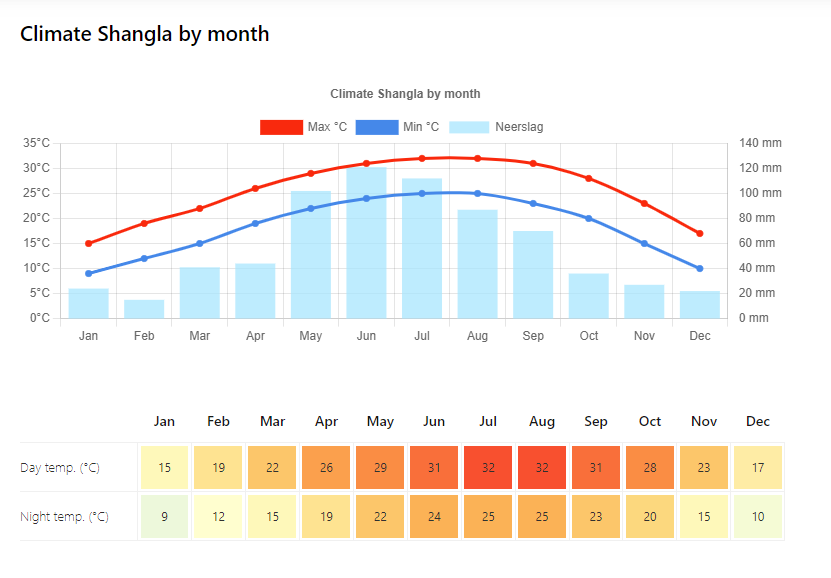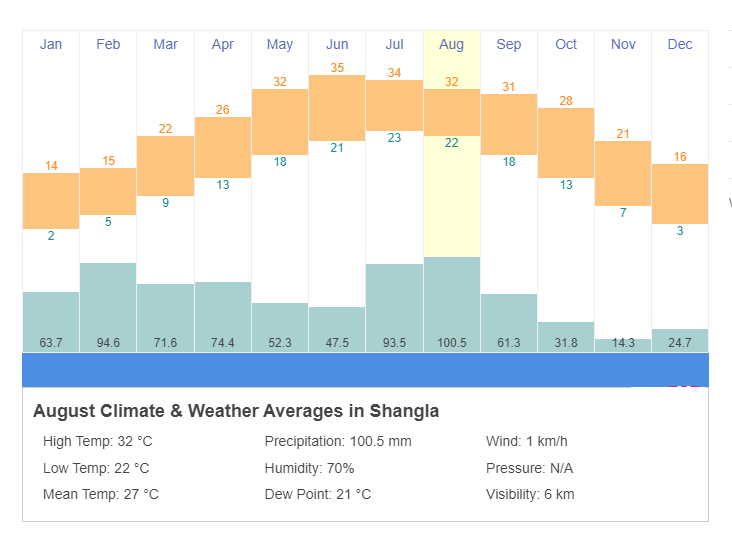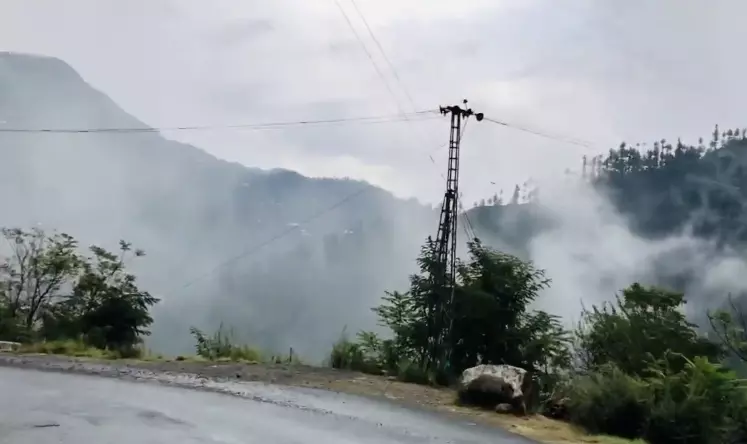Shangla Weather Forecast: A Comprehensive Guide to Weather Patterns and Climate Trends
Welcome to our thorough guide to the Shangla weather You’ve come to the correct place if you’re interested in the weather in Shangla or are simply planning a trip there. To give you the most precise and recent statistics about Shangla’s climatic patterns, our team of professionals has painstakingly collected and analyzed data. Explore the interesting world of Shangla’s weather by jumping in now!
Shangla Weather Forecast (12 Months)

Understanding Shangla’s Climate
Shangla, a city in Pakistan’s scenic Khyber Pakhtunkhwa province, enjoys a variety of climates that highlight the area’s natural beauty all year round. Its rugged geography and proximity to the Hindukush mountain range have a major impact on the climate. The winters bring a hint of magic with snow-capped peaks and frigid temperatures, while the summers are often moderate and enjoyable.
Shangla Weather Forecast: Seasons and Weather Patterns

Spring (March – May)
In Shangla, spring ushers out winter and renews the environment with burgeoning flowers and brilliant hues. This time of year, the pleasant 10 to 20 degrees Celsius (50 to 68 degrees Fahrenheit) temperatures steadily increase. The lengthening of the days makes it possible for tourists to explore the area’s verdant valleys, charming lakes, and towering mountains.
Summer (June – August)
Compared to the sweltering temperatures experienced in other parts of the country, Shangla’s summers are rather pleasant. 68 to 86 degrees Fahrenheit is the normal temperature range, providing a pleasant environment for outdoor activities. The timing is right to explore challenging hiking trails, take in flowing waterfalls, and lose yourself in the peace of nature.
Autumn (September – November)
Shangla’s scenery undergoes an incredible metamorphosis in the autumn as the foliage transforms into a kaleidoscope of vivid hues. Temperatures range from 10 to 25 degrees Celsius (50 to 77 degrees Fahrenheit), which are quite nice. This time of year is great for learning about the local customs and indulging in delectable regional food since it offers a mesmerizing fusion of natural beauty and cultural celebrations.
Orion Service
The company is providing services related to
Winter (December – February)
A beautiful winter wonderland is created in Shangla when the mountains are covered in a fresh layer of snow. Low temperatures of -5 to 10 degrees Celsius (23 to 50 degrees Fahrenheit) are possible. Adventure seekers have the ideal chance to partake in thrilling winter sports like skiing and snowboarding. Enjoy a hot cup of tea while curled up by the fire and soaking up Shangla’s calm winter beauty.

Planning Your Visit to Shangla: Weather Tips and Recommendations
Depending on the time of year you will be visiting, pack a combination of warm and lightweight clothes. To adapt to the day’s changing temperatures, layering is essential.
Sun protection: Especially in the summer, remember to pack sunscreen, sunglasses, and a hat to protect yourself from the sun’s rays.
Rain Gear: Because Shangla occasionally experiences rain, it is advised to have a small umbrella or a waterproof jacket with you to protect you from sudden downpours.
Footwear: To explore the region’s stunning trails and mountains, you’ll need comfortable walking shoes or hiking boots.
Why Choose Us for Shangla Weather Forecast?
We at orionservice work hard to give you the most precise and trustworthy weather information to improve your travels. Advanced forecasting methods and data analysis are used by our team of weather professionals to assure
Islamabad Office↗
Office no 1 VIP Palaza Ghouri Town Phase 5 Islamabad #+92 304 6020000
Lahore Office ↗
Office no 23 Defense Plaza Walton Road Lahore #+92 304 6020000
Karachi Office↗
Gulistan Colony Karachi #+92 304 6020000
Frequently Asked Questions About Shangla’s Weather
A. What are the typical temperature ranges in Shangla during summer?
The typical temperature ranges in Shangla during summer vary between 20°C to 35°C, but occasionally, it can surpass 35°C.
Three important pieces of information:
- Variation: Temperatures in Shangla during summer can fluctuate significantly between daytime and nighttime.
- Elevation Impact: Higher altitude areas in Shangla tend to experience cooler temperatures even during the summer months.
- Monsoon Influence: The summer season in Shangla also coincides with the monsoon, impacting both temperatures and precipitation.
B. How does the monsoon season affect travel plans to Shangla?
The monsoon season significantly impacts travel plans to Shangla as it brings heavy rainfall and potential landslides, affecting accessibility and safety.
Three important pieces of information:
- Accessibility Issues: Roads and trails might be impassable due to landslides or flooding during the monsoon.
- Safety Concerns: Increased rainfall can lead to dangerous conditions, particularly in hilly terrains.
- Planning Consideration: Travelers should schedule their visits outside peak monsoon months to ensure safer and more enjoyable experiences.
C. Are there any specific precautions needed for high-altitude regions in winter?
Yes, specific precautions are necessary for high-altitude regions in winter in Shangla due to extreme cold temperatures and potential altitude sickness.
Three important pieces of information:
- Cold Exposure Risks: High-altitude regions experience sub-zero temperatures, necessitating proper clothing and gear.
- Altitude Sickness Awareness: Travelers should acclimatize gradually to prevent altitude-related health issues.
- Emergency Preparedness: Access to medical facilities might be limited, so carrying essential medications and first aid kits is crucial.
D. How reliable are weather forecasts for Shangla given its unique climate?
Weather forecasts for Shangla face challenges due to its unique topography and complex weather patterns, impacting reliability.
Three important pieces of information:
- Complex Climate Dynamics: Shangla’s diverse terrain and altitude variations make accurate predictions challenging.
- Influence of Monsoons: Monsoon behavior can be unpredictable, affecting the precision of weather forecasts.
- Improving Technologies: Ongoing advancements in meteorological tools aim to enhance forecast accuracy, but challenges persist.
E. What should travelers pack when visiting Shangla in different seasons?
Travelers visiting Shangla should pack accordingly for varied seasons, including light clothing for summer and heavy winter gear for colder months.
Three important pieces of information:
- Layered Clothing: Summer demands light, breathable clothing, while winter requires warm layers, gloves, and thermal wear.
- Rain Gear: During monsoon, waterproof clothing and footwear are essential.
- Essential Accessories: Sunscreen, sunglasses, and hats for summer; snow boots and moisture-wicking socks for winter.
F. Are there any safety advisories for extreme weather situations in Shangla?
Yes, several safety advisories are crucial for extreme weather situations in Shangla, including staying updated on weather forecasts and avoiding risky activities during adverse conditions.
Three important pieces of information:
- Stay Informed: Regularly check weather forecasts and heed warnings issued by local authorities.
- Exercise Caution: Avoid trekking or outdoor activities during severe weather conditions.
- Emergency Contacts: Keep emergency contact numbers and inform someone about your travel plans.
G. How do geographical factors influence Shangla’s weather patterns?
Geographical factors like altitude, topography, and proximity to water bodies significantly influence Shangla’s weather patterns.
Three important pieces of information:
- Altitude Variation: Higher altitude areas experience cooler temperatures compared to lower regions.
- Topographical Impact: Mountains and valleys can create microclimates, leading to varied weather conditions within short distances.
- Water Bodies Influence: Proximity to rivers or lakes can moderate local temperatures and impact precipitation.
H. What are the primary challenges faced by meteorologists when predicting weather in Shangla?
Meteorologists face challenges predicting weather in Shangla due to its diverse terrain, altitude variations, and the unpredictability of monsoon patterns.
Three important pieces of information:
- Topographic Complexity: Shangla’s varied landscape poses challenges in understanding localized weather phenomena.
- Monsoon Variability: The unpredictable nature of monsoons complicates long-term forecasting.
- Limited Data: Sparse meteorological data in some regions of Shangla affects the accuracy of predictions.
I. How does altitude impact temperature variations in Shangla?
Altitude directly impacts temperature variations in Shangla, where higher altitudes experience cooler temperatures compared to lower regions.
Three important pieces of information:
- Temperature Gradient: For every 1000 meters increase in altitude, temperatures can drop by approximately 6°C to 10°C.
- Localized Climate: Variation in altitude creates diverse microclimates within Shangla.
- Altitude Sickness Risk: Higher altitudes pose health risks due to decreased oxygen levels and colder temperatures.
J. Are there notable differences between weather patterns in urban and rural areas of Shangla?
Yes, notable differences exist between weather patterns in urban and rural areas of Shangla due to various factors like urbanization, land use, and heat retention.
Three important pieces of information:
- Urban Heat Island Effect: Urban areas may experience slightly higher temperatures due to concrete and infrastructure retaining heat.
- Rural Landscapes: Open rural spaces might have more significant temperature fluctuations between day and night.
- Precipitation Variances: Urbanization can affect rainfall patterns, sometimes causing more runoff in cities compared to rural areas.
| Waterproofing Services | Rawalpindi | Islamabad | Lahore | Karachi |
| Waterproofing In Rawalpindi | Rawalpindi | Islamabad | Lahore | Karachi |
| Basement Waterproofing Services | Rawalpindi | Islamabad | Lahore | Karachi |
| The Importance of Wall Waterproofing | Rawalpindi | Islamabad | Lahore | Karachi |
| Bathroom waterproofing | Rawalpindi | Islamabad | Lahore | Karachi |
| Water tank waterproofing | Rawalpindi | Islamabad | Lahore | Karachi |
| Foundation Waterproofing | Rawalpindi | Islamabad | Lahore | Karachi |
| Heat Proofing Services | Rawalpindi | Islamabad | Lahore | Karachi |
| Termite proofing Services | Rawalpindi | Islamabad | Lahore | Karachi |
| Fumigation And Pest Control Service | Rawalpindi | Islamabad | Lahore | Karachi |
| Cockroach Control Services | Rawalpindi | Islamabad | Lahore | Karachi |
| Mosquito Control Services | Rawalpindi | Islamabad | Lahore | Karachi |
| Lizard Control Services | Rawalpindi | Islamabad | Lahore | Karachi |
| Rodent Control Services | Rawalpindi | Islamabad | Lahore | Karachi |
| Bed Bug Control Services | Rawalpindi | Islamabad | Lahore | Karachi |
| All Insects / Pests Control Services | Rawalpindi | Islamabad | Lahore | Karachi |
| Water Tank Cleaning Services | Rawalpindi | Islamabad | Lahore | Karachi |
For any inquiries, feedback, or support, feel free to reach out to us through any of the above channels. We’ll be happy to assist you!
Social Media:
Contact US: @contactus
Facebook: facebook.com/orionservices.pk
Twitter: twitter.com/orionservice
Instagram: instagram.com/orionservices.pk
YouTube: YouTube.com/@OrionServices
Pinterest: Pinterest.com/orionservicespk
Reddit: Reddit.com/@orionservice
Flickr: Flickr.com@orionservice
Tumblr: Tumblr.com/@orionservice
WhatsApp: +923046020000 (Please note that this number is for WhatsApp messaging and voice calls)
Shangla Weather Forecast Related Topic:






